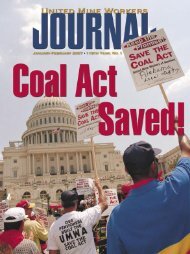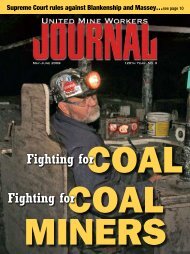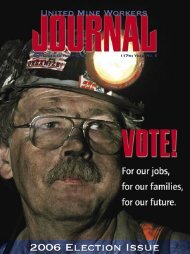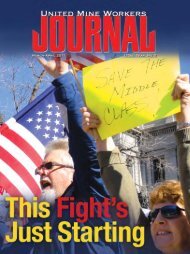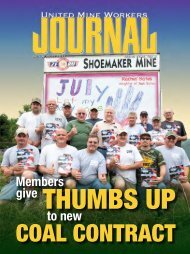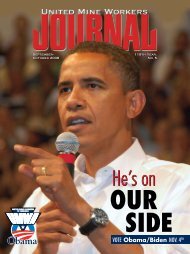January - February - United Mine Workers of America
January - February - United Mine Workers of America
January - February - United Mine Workers of America
You also want an ePaper? Increase the reach of your titles
YUMPU automatically turns print PDFs into web optimized ePapers that Google loves.
our<br />
health&safety<br />
Drug test diversion<br />
It remains unclear what will happen with a misguided<br />
drug and alcohol initiative launched during the waning<br />
months <strong>of</strong> the Bush administration.<br />
The rule would require all mine operators to establish<br />
a drug and alcohol program based on guidelines drawn<br />
from regulations governing the<br />
transportation industry. Yet the<br />
vast majority <strong>of</strong> coal miners<br />
already are tested for drugs and<br />
alcohol, and most coal companies<br />
have already implemented testing<br />
programs. According to MSHA’s<br />
own data, 80 percent <strong>of</strong> coal miners<br />
already have to pass pre-employment drug and alcohol<br />
screening tests. Seventy-five percent <strong>of</strong> miners are subject<br />
to random testing by their employers, and under current<br />
regulations, all miners who are working in a section <strong>of</strong> a<br />
mine where a safety incident occurs can automatically be<br />
tested for drugs and alcohol.<br />
Ironically, although much <strong>of</strong> the incentive to devise<br />
this new rule was prompted by recent major coal mine<br />
disasters, such as Sago, Aracoma, Darby and Crandall<br />
Canyon, there was no indication <strong>of</strong> drugs or alcohol being<br />
To push this rule, MSHA established<br />
a hearing format that effectively<br />
denied most UMWA members<br />
the opportunity to testify.<br />
contributing factors to those tragedies. In each <strong>of</strong> those<br />
cases, the actions or inactions <strong>of</strong> mine management and<br />
MSHA itself were to blame.<br />
To push this rule, MSHA established a hearing<br />
format that effectively denied most UMWA members<br />
the opportunity to testify. It<br />
devoted thousands <strong>of</strong> hours <strong>of</strong><br />
government employees’ time and<br />
millions <strong>of</strong> dollars <strong>of</strong> taxpayers’<br />
money on the rule instead <strong>of</strong><br />
focusing on more pressing safety<br />
and health issues.<br />
For example, data published<br />
by the National Institute for Occupational Safety and<br />
Health show that black lung disease is once again on the<br />
rise, afflicting thousands <strong>of</strong> miners, even younger miners<br />
who have been working in the industry only a short time.<br />
The UMWA has been aggressively seeking action from<br />
MSHA to protect miners from respirable coal and silica<br />
dust for many years, yet nothing has happened. Instead,<br />
Bush’s MSHA Assistant Secretary <strong>of</strong> Labor told a reporter<br />
that “there’s no way I’m going to get that done with what I<br />
have on my plate.”<br />
Shoemaker rescuers take honors<br />
The <strong>Mine</strong> Rescue Team at Consol’s Shoemaker <strong>Mine</strong> in Marshall County,<br />
W.Va., came in first place in competition with all Consol teams in 2008.<br />
UMWA members <strong>of</strong> the team include Carl Cochran, Jr., Ed Fisher, Bob<br />
Haines, Ted Hunt, Travis McNabb, Okey Rine, George Starkey, Ron Taylor<br />
and Cliff Ward.<br />
Belt air rule<br />
On the last day <strong>of</strong> the year,<br />
MSHA published the final rule<br />
for “Flame-Resistant Conveyor Belt,<br />
Fire Prevention and Detection and<br />
Use <strong>of</strong> Air from the Belt Entry.” The<br />
UMWA has consistently opposed<br />
the use <strong>of</strong> the belt entry to ventilate<br />
working sections because <strong>of</strong> fire<br />
hazards in that entry. Nonetheless,<br />
the final rule continues to permit the<br />
use <strong>of</strong> the belt entry for ventilation.<br />
In other provisions, the rule also<br />
requires better belt maintenance,<br />
standardized evacuation and<br />
emergency gear signs, installation<br />
<strong>of</strong> smoke sensors in underground<br />
working sections and reduction <strong>of</strong><br />
dust levels on the belt line.<br />
18 <strong>January</strong>/<strong>February</strong> 2009 • <strong>United</strong> <strong>Mine</strong> <strong>Workers</strong> Journal



